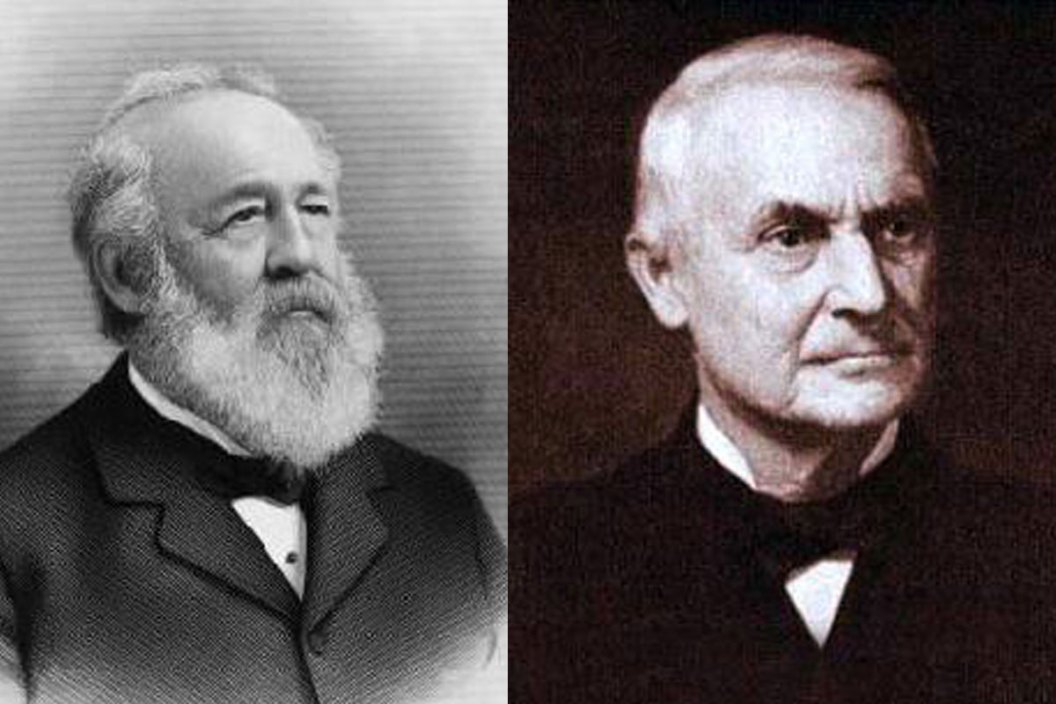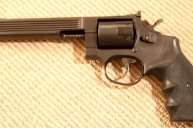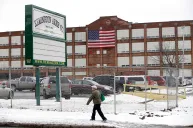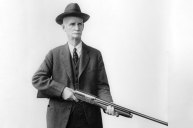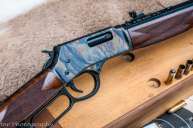The story of the two men behind one of the biggest gun companies of all time.
The name is as recognizable to pretty much everyone as Colt, Winchester, and Remington. Ask anybody what Smith & Wesson is and they know its a gun company—and some will associate the name with handguns more than anything else.
That's all true, but not many people know who Smith and Wesson were. Let's meet the men behind one of the oldest and most storied firearm brands in the United States.
The Men Behind the Name
In 1852, two men named Horace Smith and Daniel B. Wesson formed the Smith & Wesson Company in Norwich, Connecticut to develop the repeating Volcanic rifle, an early precursor to the lever action rifle.
While that particular company didn't last very long, the next one they'd form together would do considerably better.
Smith was born in Cheshire, Massachusetts in 1808. He worked for the U.S. Armory Service from 1824 to 1842 when he moved to Newtown, Connecticut where he was employed by various gun makers before moving to Norwich.
Records show he was listed as a partner of a company called Cranston & Smith and that he engaged in the manufacture of whaling guns. Smith is also credited with inventing an explosive bullet that was used to kill whales back when lamp oil was still a thing.
Daniel Baird Wesson was born to a farmer in 1825 who also made wooden plows. Wesson worked on his father's farm and went to public school until the age of 18. At that time, he became an apprentice to his brother, Edwin Wesson, in Northborough, Massachusetts, who was a leading manufacturer of target rifles and pistols in the 1840s.
He married and had one daughter and three sons.
The paths of the two men intersected in the 1850s. In 1854 ,they officially partnered up along with Courtlandt Palmer to develop a lever action pistol and rifle, the latter of which would prove to be the very first repeating rifle ever made.
The guns were produced in Horace Smith's shop in Norwich, originally under the name "Smith & Wesson Company," which was soon changed to "Volcanic Repeating Arms" in 1855 after the name given to their new firearms.
The renaming also came with new investors, one of whom was Oliver Winchester. As such, The Volcanic Repeating Arms Company now owned all the gun and ammunition designs that were once owned by the original S&W Company.
The founding duo were somewhat marginalized as sales of the innovative but underpowered Volcanic guns flagged. Smith left the company, and after eight months working as the Volcanic plant manager, Dan Wesson joined him to found the Smith & Wesson Revolver Company after obtaining the licensing rights to the "rear loading cylinder" patent from Rollin White, but more on White in a second.
Volcanic went under in late 1856 and was reorganized as the New Haven Arms Company in 1857, and later as the Winchester Repeating Arms Company, which was producing the most popular lever guns in the world by the time of the American Civil War.
Sam Colt's Loss is S&W's Gain
This was a very advantageous time for Smith & Wesson to get into the revolver business, as Samuel Colt's patent on the revolver expired in 1856. Knowing this, Wesson came up with a prototype for a revolver that used new metallic cartridges using an invention created by a gunsmith who once worked for Colt.
When Rollin White figured out how to design a cylinder for new metallic cartridges, he took it right to his boss, Samuel Colt, who promptly brushed him off. Believing in his invention, White left Colt and hooked up with Smith and Wesson, who bought the licensing rights to his design.
White wasn't a partner. Instead he made $0.25 on every revolver the company made and was ultimately ruined trying to defend his patent in court.
However, Smith & Wesson became the first company to make a metallic cartridge revolver, and thanks to White's patent, Colt and other gun companies couldn't make one for almost 20 years, though they tried.
Civil War Period
When the American Civil War broke out, S&W saw a huge demand for their revolvers on both sides of the conflict. While their guns weren't officially issued by either army, orders for the Smith & Wesson Model 1 revolver outpaced production capabilities in 1860. Around then, the company expanded into a larger facility and began experimenting with rounds other than the .22 Short rimfire cartridge, the only chambering for their revolver at the time.
As the Civil War ended, demand for revolvers declined in general and Smith & Wesson focused on guns suited for the American frontier.
Post War
In 1870, the company switched its focus from pocket-sized revolvers to large revolvers in big calibers, introducing the .44 S&W American cartridge for the new Smith & Wesson Model 3 top break revolver, later known as the Schofield Revolver.
The U.S. Army adopted the Model 3 as the United States' first cartridge pistol. However, because S&W refused to chamber it in the more widely used .45 Colt, which was very similar to the .44 S&W, but not interchangeable, the Army, which had already bought a whole bunch of .45 Colt ammo, ultimately decided to go with the Colt SAA instead before the Model 3 contract could be fulfilled.
Into the 20th Century
The company would go on to have many successes. In 1899 it produced its most widely used revolver of all time, the double action .38 Military & Police, also known as the Model 10. Over six million were made and it was the standard sidearm for most police officers for the majority of the 20th century. A million Model 10s were also made for the U.S. Military during World War II.
Before and after the war, S&W continued to innovate. In 1938, the S&W Model 27 was the first revolver chambered for the .357 Magnum cartridge, and was built to be a more powerful handgun for law enforcement. Thus began the so-called "Magnum Era" of revolvers.
In 1955, S&W released the Model 29 for the powerful new .44 Magnum cartridge, which was an uploaded version of the .44 Special. Sales weren't great and the gun was discontinued for a time, until it was wielded by Clint Eastwood in the first Dirty Harry movie in 1971 made the Model 29 and the .44 Magnum famous. The gun was put back into production and sales skyrocketed.
The Wesson Family Steps Back
In 1965, the Wesson family sold its controlling interest in the company to an American conglomerate, Bangor Punta, and it has changed ownership several times since. In the 21st century, the company is still one of the leading companies in the gun industry worldwide.
On Nov. 7 2016, Smith & Wesson Holding Corporation officially changed its name to American Outdoor Brands Corporation.
What Became of Horace Smith and Dan Wesson?
But what became of the two men who founded the company all those years ago and helped begin the firearms industry in the United States?
Horace Smith sold his interest in the company to Wesson in 1874 at the age of 65 and retired. He died on Jan. 15, 1893. The Horace Smith Fund was established in 1899 in accordance with his wishes from his estate to fund scholarships for worthy graduates from secondary schools in Hampden County, Massachusetts.
Dan Wesson, on the other hand, remained active at the company until he died on August 4, 1906 after a long illness. Wesson was big into homeopath and donated $100,000 to the Hampden Homeopathic Hospital in Springfield, Massachusetts in 1904. he hospital became the Wesson Memorial Hospital and began practicing modern medicine in 1923. It became part of the Baystate Medical Center in 1976.
Wesson's grandson, Douglas B. Wesson, was in the family business and helped create the .357 Magnum cartridge in the 1930s. Wesson's great grandson, Daniel B. Wesson II, was also in the family business for 30 years and founded his own company, which later became Dan Wesson Firearms.
Overall, the impact of Smith & Wesson firearms is undeniable. The name will only become more familiar over time.
NEXT: 5 OF THE BEST HAMMERLESS REVOLVERS
WATCH
